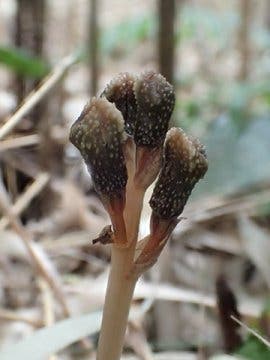A new species of plant has been discovered on the Japanese island of Kuroshima. Named Gastrodia kuroshimensis the plant doesn’t photosynthesize and grows flowers that never bloom.

Mycoheterotrophic or non-photosynthetic mycorrhizal plants are a mouthful. They’re also a pretty awesome class of plant, which draw their sustenance from symbiotic fungi instead of basking in the sun like other, lazier plants do. They tend to be small in size and inhabit the dark, wet under-story of forests, and tend to stay hidden until their flowering and fruiting period when they push above-ground organs through the fallen leaves. So it’s pretty hard to know which species form this group, how many of them, and where they are.
Project Associate Professor Kenji Suetsugu of Kobe University Graduate School of Science was involved in documenting the where and who’s of mychoeterotrophic plants in Japan. In April, he came upon approximately one hundred individuals of an unfamiliar species in the lowland forests of Kuroshima, Japan. He collected a specimen, examined it in detail and discovered a new species.
Discovering a new species of flowering plant in Japan is a pretty rare occurrence, as the flora here has been thoroughly investigated over the years. But G. kuroshimensis was an even more surprising find, as it’s both fully fungi-fed, and totally clesitogamous (CG)– meaning it produces flowers but they never bloom.
Meaning “closed marriage”, this term refers to plants which self-fertilize in closed flower buds. Ever since Darwin’s theories gained ground, botanists have been intrigued by this mechanism of reproduction as it essentially uses genes from a single parent. It can be a really powerful strategy — CG flowers require less material and energy to create than their open counterparts, they’re a surefire way of getting offspring even in the absence of mates, pollinators, or in dire environmental conditions. CG reproduction also helps flowers promote adaptation to the local habitat, as both sets of a mother’s genes can be passed on to an offspring, which tends to weed out bad alleles (genes).
But it also poses huge risks. It restricts the total gene pool and wrecks diversity, leaving a population at risk from diseases or environmental strain. It also leaves the species as a whole less able to adapt to environmental changes. To offset this lack of genetic variability, most CG plants also produce cross-pollinating flowers. But not G. kuroshimensis — it’s fully CG.
Researchers are still unsure as to why. Even a small degree of gene-mixing from cross-pollinating flowers is enough to keep a population healthy. A total absence of this mechanism seems counter-intuitive from an evolutionary point of view.
Hopefully, further studies into this little plant’s life will offer more insight into why it chose to close its marriage for good.
The full paper “Gastrodia kuroshimensis (Orchidaceae), a new mycoheterotrophic and complete cleistogamous plant from Japan” has been published in the journal Phytotaxa.






